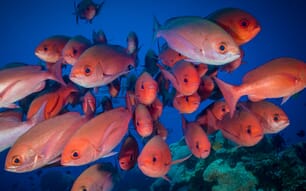Identity
Hypophthalmichthys nobilis Richardson, 1845 [Cyprinidae]
FAO Names: En - Bighead carp, Fr - Carpe à grosse tête, Es - Carpa cabezona
View SIDP Species fact sheet
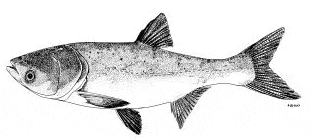
Biological features
Body laterally compressed, round abdomen before ventral fin, narrow abdominal edge between ventral fin and anus; standard length is 3.1-3.5 times of body height and 3.0-3.4 times of head length; head large; length of head is larger than body height; terminal mouth and slanting upwards; lower jaw extends slightly over upper jaw; no palpus; gill rakes dense and large in number (more than 400), not connected; one row of pharyngeal teeth on each side, flat and smooth, formula 4-4; scales small, extreme 96-110 in lateral line, lateral line extends to caudal peduncle. Tip of ventral fin reaches and exceeds anus; dorsal fin ray: 3,7; pectoral fin ray: 1,17; ventral fin ray: 1,8; anal fin ray: 3, 12-13; body colour: black in dorsal and upper lateral portion, silvery white in abdomen, irregular black spots on the lateral side of body; greyish colour in fins.
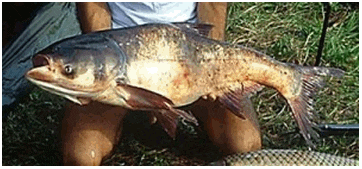
Profile
Historical background
Bighead carp culture was first initiated in the areas along Yangtze River and Pearl River in the southern part of China, much later than the culture of common carp. According to historical record, the beginning of culture bighead carp was closely related to the will of the current governor. In the Tang Dynasty, the family name of the emperor happened to be pronounced the same as the Chinese name for common carp, the only fish cultured then. The royal family prohibited common carp to be sold and killed by the people. Therefore, bighead carp was chosen by the farmers as a substitute for aquaculture, together with silver carp, grass carp and black carp; this was because the seed of these fish were easily available in the areas along the Yangtze and Pearl Rivers. The culture of bighead carp remained relatively small in scale, due to the dependence on the natural supply of seed. Success in induced breeding technology significantly promoted its culture. The fish has been introduced to more than 20 other countries. There has been an increasing trend in the production of farmed bighead carp since the 1970s. China is by far the major producer (1.7 million tonnes in 2002, 98.7 per cent of the global total).
Main producer countries
Many countries and regions report farmed production of bighead carp to FAO but only some of them (China, Taiwan Province of China, the Islamic Republic of Iran, the Lao People's Democratic Republic, Nepal, Malaysia and Myanmar) reported production of over 1 000 tonnes. It is also believed that production exceeds this level in the US.
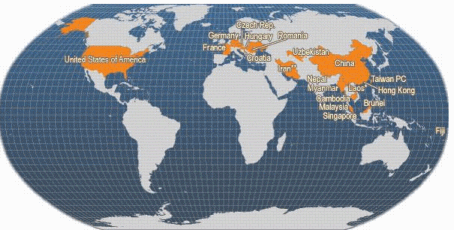
* the Lao People's Democratic Republic.
** Islamic Republic of Iran.
Habitat and biology
Bighead carp is a eurythermic fish, being able to tolerate water temperatures of 0.5-38 °C. It is a native freshwater fish in China, with a broad distribution from the drainage areas of the Pearl River in southern China to those of the Heilongjiang River in the north. It inhabits lakes, rivers and reservoirs. Bighead carp normally dwell in the upper layer of the water column and prefers high fertility water with abundant natural food.
Though it has been introduced into many other countries (mainly Asia and Eastern Europe), very little information is available on the distribution of the species in natural water bodies in those countries. However, it has been reported that a natural population of bighead carp has been found in the Red River in Viet Nam.
Bighead carp is a synchronous and gonochoristic species that spawns annually for dozens of years during its life span. There is just one spawning season in a year, which takes place in early summer. Bighead is a semi-migratory fish. Broodstock migrate from lakes and the lower reaches of rivers to the spawning ground in the upper reaches of the major rivers in China in the spawning season. Flowing water and changes in water level are essential environmental stimuli for natural spawning. Semi-buoyant eggs are laid that suspend in the water column when there is a current. Bighead carp can reach sexual maturation in captivity but cannot spawn naturally under these conditions. Hormone injection and environmental stimuli such as flowing water are essential for induced spawning.
This species is basically a zooplankton feeder throughout its life under natural conditions. In culture, bighead carp will also accept artificial feed, such as the by-products from grain processing and organic detritus, in addition to natural food.
Bighead carp are fast growing and become very large, reaching a maximum weight of 40 kg.
Production
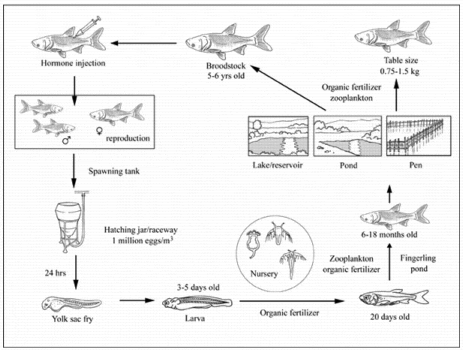
Production systems
Due to the natural features of bighead carp, the systems used for its culture are rather limited. Extensive culture in open-waters and pond-based polyculture are the major systems used. The most important factor involved in the production of bighead is to ensure a sufficient supply of quality seed. Comparatively, it is more difficult to breed bighead than other fish, due to their slow gonadal development. It is also more difficult to produce large-size fingerlings, due to their slow growth in the early developmental stage. Seed supply
Artificial propagation is the major supply of seed for the culture of bighead carp, although natural seeds are still available in some Chinese rivers. Seed collected from natural waters is mainly used for maintaining the quality of broodstock. The broodstock used for artificial propagation is usually raised in captivity with seed from the wild or from breeding stations, where good natural stock are maintained.
Hatchery production
Induced breeding is applied for bighead. Well-matured breeders are released into a spawning tank (round cement tank 6-10 m diameter; water depth ~ 2 m) after being injected with inducing hormone (normally HCG and PG). Water circulation is maintained throughout the spawning period.
The eggs are transferred to a hatching raceway or hatching jar, either manually or by gravity. Hatching raceways, which are round or ellipse-shaped cement structures, are commonly used for large scale production. Their width is normally 0.8 m and their depth 0.8-1.0 m. The inlets are mounted on the bottom of each raceway, and open in the same direction and at an angle of around 15° to the bottom surface. Screens are mounted on the inner wall for the regular discharge of water. Eventually, water can be totally drained through the outlet on the bottom. A current is maintained during the hatching period to keep the eggs and larvae suspended in the water column.
Nursery
Earthen ponds are used for the nursing of bighead carp. Ponds are usually 0.1-0.2 ha in area and 1.5-2.0 m deep. Ponds are chemically cleared, normally with quicklime, to eliminate all harmful organisms after totally drying. The usual dose is 900-1125 kg/ha.
Organic fertiliser - animal manure and/or plant wastes ('green manure') is commonly applied to increase the natural biomass of zooplankton 5-10 days before the stocking, according to the water temperature. The quantity of organic fertiliser used is usually 3000 kg/ha for animal manure or 4500 kg/ha for green manure. Green and animal manures can be used simultaneously but the quantity of each should be reduced accordingly.
Monoculture is practiced in the nursery stage, with a stocking density normally ranging between 1.2-1.8 million/ha, depending on the length of rearing and targeted size. The nursery operation usually takes 2-3 weeks in China. Organic fertilisation is carried out at frequencies and rates sufficient to maintain high pond fertility and therefore a good supply of natural food organisms (especially zooplankton) for the fish. The quantity ranges from 1500-3000 kg/ha once every 4-5 days for animal manure or green manure, depending on existing water fertility. Soybean milk can also be used as both direct feed and fertiliser to replace organic fertiliser in the nursery stage. The normal quantity is 3-5 kg (dry soybean)/100 000 fish daily. This usually means production costs are high. Using a paste-form of soybean cake or other by-products from grain processing may be needed if poor growth of fish is observed in the later part of the rearing period. The quantity is usually 1.5-2.5 kg/100 000 fish daily. Normal survival rates in nursery ponds are 70-80 per cent, although it may reach over 90 percent under good management.
The fish usually reach the size of about 30 mm in length after 2-3 weeks of rearing. These are called summer-fingerlings in China and are ready for the fingerling rearing stage. Conditioning, through careful netting and holding the fish at high density for a while (several hours) is required before the transfer of summer-fingerlings to the fingerling pond. This practice is designed to increase fish tolerance to stress before they are transported.
Rearing fingerlings
Summer-fingerlings are not suitable for direct stocking in grow-out ponds; they need to be reared to the fingerling stage (13-15 cm in length) first. The technique for fingerling rearing is rather similar to the nursery operation, including the feeding and fertilisation regime. The major differences include the following:
- Relatively larger (0.2-0.3 ha) and deeper earthen ponds are used for fingerling rearing.
- Contrary to the nursery stage, polyculture is commonly adopted for the production of bighead carp fingerlings. Bighead carp can be polycultured with other carp species but not silver carp. Monoculture is rarely practiced in production of bighead carp fingerling.
- The stocking density is around 120 000/ha when it is the major species in the pond or 30 000-60 000/ha when it is the secondary species.
- Fingerling rearing normally takes 4-6 months for above mentioned size and stocking density in China. The period can be considerably shortened in warmer climates or if lower stocking densities are used.
- The normal survival rate through the whole fingerling rearing period should be above 95 per cent.
In Viet Nam, the rearing of bighead carp before the grow-out stage is divided into two periods. Fry are first raised to 2.5-3 cm, with a stocking density in the nursery pond that is slightly higher than grass carp (c/f grass carp fact sheet). Then the fish are further raised to the size of 6-12 cm at a much lower density. Here, the rearing of bighead carp seed usually takes 45-50 days. The fish is usually fed with soybean powder, maize powder and rice bran.
Ongrowing techniques
The most commonly adopted techniques for ongrowing (grow-out) bighead carp are polyculture in pond and pens and extensive culture in lakes and reservoirs.
Polyculture in ponds and pens
In China, bighead carps are usually cultured as secondary species together with other carp species. The grow-out stocking density is 750-1500/ha of 13-15 cm fingerlings. If selective harvesting is to be practiced, a certain proportion of larger sized fish (up to 250 g) is also stocked. There is no special feeding/fertilisation required for bighead when herbivorous and omnivorous fish are cultured as the main species. However, organic fertiliser is usually applied to raise natural food if bighead and silver carp are cultured as major species. The fish can reach marketable size (750-1500 g) within 8-10 months in China. The culture period may be much shorter in tropical and subtropical areas. The yield of bighead carp is usually 500-1000 kg/ha, which accounts for 10-15 per cent of the total production.
In Viet Nam, bighead grow-out is conducted through polyculture with other species, such as grass carp, silver carp, rohu, mrigala, common carp and tilapia. Bighead carp is stocked as a minor species in the ponds, usually accounting for 3-5 per cent of the total. However, bighead carp usually account for 5-7 per cent of the total production. No special feeding for bighead carp is practised. The market size of bighead carp is 2.5-3 kg.
Extensive culture in small lakes and reservoirs
In this system, bighead carp are usually stocked as the major species, with a stocking density of 150-750/ha, depending on the size and fertility of the water body. This level represents about 40-50 per cent of the total number of fish stocked. The stocking size is usually 13-15 cm. A small percentage of large fingerlings (up to 250 g) is also stocked for selective harvesting to fully utilise the water and the available natural food. Neither feed nor fertiliser is used in this form of rearing. The production of bighead can reach 150-400 kg/ha, which accounts for 40-60 per cent of total production.
Harvesting techniques
Selective harvests are taken in the later part of the culture period and are normally conducted in the early morning (when temperatures are relatively low, and for morning marketing). Individuals of marketable size are selected after netting (one netting per harvest). Several partial harvests are usually carried out before total draining of the pond for the final harvest. At this final harvest the fish are either marketed or used for restocking (individuals below marketable size) for the next production cycle.
Handling and processing
Bighead are usually consumed fresh, with the exception of some reservoir fisheries, where it is difficult to market them all fresh due to their remote location. Some of the production is canned.
Production costs
Being produced through natural food, there is no supplementary feed input for grow-out. The major inputs are seed and management, and sometimes fertilisers. Thus total rearing costs are very low. The seed cost usually comprises more than 50 per cent of the total production cost, which is normally less than USD 0.20/kg.
Diseases and control measures
The major diseases of bighead carp and the methods of control are listed in the table below.
| DISEASE | AGENT | TYPE | SYNDROME | MEASURES |
|---|---|---|---|---|
| Bacterial Septicemia | Aeromonas sobria; Aeromonas hydrophila; Yersinia ruckerri; Vibrio sp. | Bacteria | Hyperaemia at different positions of body, such as jaws, mouth cavity, operculum, fin-base and whole body when serious; protruded eyeball; swollen anus; expanded belly; erected scales; gill rotten and reduced feeding; high mortality of infected fish | Disinfecting the fish and culture environment with quicklime and potassium permanganate; 'Yu Tai III' (commercial drug of multi herb ingredients) through medicated feed |
| Stigmatosis | Aeromonas punctata sub. punctata | Bacterium | Round red spot on skin and muscle near anus of fish; loose scale; rotten skin and muscle even reaching the bone; physically weak and slow movement; much reduced feeding; die of exhaustion | Spraying of bleaching powder or furazolidone solution in pond; dipping infected fish in potassium permanganate or furazolidone solution; antibiotics |
| White head-mouth disease | Myxococcus sp. | Bacteria | Whitish colour in mouth and front part of head; swollen lips; difficulty in breathing because of losing control in mouth movement; ulceration of skin around the month | Dipping the fish in 2-2.5 per cent saline water or 1% rhubarb Rheum officinale solution before stocking; spraying of rhubarb Rheum officinale solution over the pond at a concentration of 2.5-3.7 ppm or a solution of furazolidone at a concentration of 0.1-0.2 ppm |
| Myxosporidiasis | Myxobolus drigini | Protozoan | Spore of parasite visible on body or inside body; swimming frantically; may finally die of exhaustion | Clearing pond with quicklime or nitrolime (CaN2) before stocking; dipping the fish in the solution of dipterex and spraying the solution over the pond; difficult to treat due to very resistant cover of the parasite |
| Trichodiniasis | Trichodina sp. | Protozoan | Dark body colour; obvious macilency (loss of weight); slow in movement; high mortality of juvenile fish | Clearing pond with quicklime and dipping fish in 0.3 per cent saline water or 0.5 ppm dipterex solution before stocking; spraying dipterex solution over the pond at concentration of 0.2 ppm |
| Lernaeosis (anchor worm) | Lernaea sp. | Copepod | Parasitizes into the muscles; swims abnormally; feeds little and gradually dies | Thorough clearing of pond with quicklime before stocking; spraying solution of 90 per cent dipterex in pond at the concentration of 0.3-0.5 ppm; dipping the infected fish in potassium permanganate solution at 10-20 ppm for 1-2 hours |
| Saprolegniasis: Dermatomycosis (Water-mould disease) | Saprolegnia spp.; Achlya spp. | Fungus | Whitish fungus mycelia visible on the body; cotton-like; weakened body or even die of exhaustion | Careful handling of fish and disinfection of pond with quicklime; immersing infected fish in potassium chloride solution or malachite green solution |
Suppliers of Pathology Expertise
The following can provide expertise in this topic:
- Research Institute of Hydrobiology, CAS, Wuhan City, Hubei Province, China.
- Shanghai Fisheries University, Shanghai, China.
- Pearl River Fisheries Research Institute, CAFS, Guangzhou City, China.
- Freshwater Fisheries Research Centre, CAFS, Wuxi, Jiangsu Province, China.
- Zhejiang Provincial Freshwater Fisheries Research Institute, Huzhou City, Zhejiang Province, China.
Statistics
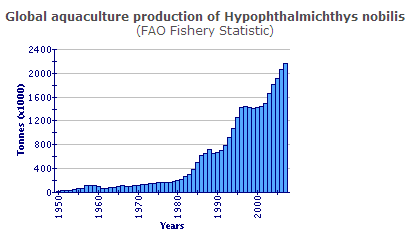
Global production of farmed bighead carp was only 15 306 tonnes in 1950. It reached 1 722 832 tonnes by 2002, an increase of more than 112 times in 52 years. Bighead carp ranks 5th among all cultured freshwater fish globally. Bighead carp contributed 7.5 per cent of the world freshwater aquaculture production in 2002. Between 1950 and 2002, Chinese production increased by a factor of x129 times, whereas production elsewhere increased at a much lower rate (a factor of x10 ).
In the past decade (1993-2002) the average global annual growth rate of farmed bighead carp production was 7.2 per cent; in the mainland of China it was 7.3 per cent but in the rest of the world it was only 0.2 per cent. However, the expansion rate in China has slowed recently. Between 1999 and 2002 Chinese bighead production increased at 2.3 per cent/yr.
The total value of cultured bighead carp production globally was USD 1.48 billion in 2002, an annual expansion rate between 1993 and 2002 of 5.7 per cent/yr. The slower growth rate in terms of value, as compared to volume, was mainly due to changes in the valuation of the Chinese RMB yuan against the US dollar.
Market and trade
Traditionally, bighead carp are consumed fresh in China, as well as most other producing countries. Most of the production is marketed fresh, either as whole fish or as pieces. Very little production is processed. At the present time, bighead carp is mainly consumed locally. In China, the major producer, the production is basically locally consumed. However, some production from Guangdong province (southern China) is marketed to Hong Kong and Macao. There is no specific data on the quantity of exported bighead carp in Chinese statistical information. However, 41 798 tonnes and 4932 tonnes of live fish (species not specified) were exported to Hong Kong and Macao from the mainland of China in 2002, according to the national statistics yearbook of imports and exports of aquatic products. Bighead carp must have comprised large proportion of this total.
Bighead carp is a low price commodity affordable to middle and low income classes in China and other countries. The price of bighead carp in the past few years has changed little in China. At present, the actual retail price is usually USD 0.60-0.90/kg. There are no specific regulations relating to the marketing of the bighead carp because the fish is basically for local consumption.
Status and trends
There has been some development in the techniques used in bighead carp culture, even though the fish has been farmed for more than a thousand years. The most significant technical progress has been the success in its induced breeding, with broodstock raised under captivity. This has ensured a sufficient supply of seed at low cost. Other progress has mainly been in developing preventive and control measures for some significant diseases of this species. Almost no progress has been made in genetic improvement, despite trials on cross breeding with silver carp. Various stocking models have also been studied, in order to achieve optimum production.
Bighead carp can be produced at very low cost through organic fertilization or the use of wastes discharged by other fish polycultured in the pond. The culture of bighead carp can be well integrated into crop farming and livestock production to maximize the utilization of natural resources. Bighead carp can be produced with very limited inputs and low costs.
The seed can be produced through artificial propagation in large scale at rather low cost. This species is suitable for poor fish farmers who cannot afford high production costs, such as commercial feed, etc. It is also suitable for community based aquaculture in common shared water bodies. It has significant potential for freshwater aquaculture development in developing countries and it is suggested that it should be strongly promoted for this purpose. Efforts should also be made to popularize the Chinese technique for the induced breeding of this species where there is good potential for development.
Main issues
Bighead mainly depend on natural food. Therefore, the yield is mainly limited by natural productivity. Production is also limited by seed supply in some countries, where the techniques for artificial propagation have still not fully been mastered. In semi-intensive and intensive culture systems, it can be stocked as secondary species. In this case, its production is entirely dependent on the wastes from other fish and unutilized feeds. Organic fertilization can significantly increase the production of bighead carp in extensive culture.
The major limiting factor in the culture of bighead is the market. Small size bighead carp are not very good in meat quality and have a lot of fine inter-muscular bones. This affects the market price and acceptability for consumers in many countries and means that profit margins are low. Nowadays, bighead is becoming less popular with consumers in urban areas in China. However, the meat quality of bighead carp can be significantly improved by rearing it to a larger harvest size (>1.5 kg). It is not very difficult to raise the fish to this size in tropical and subtropical areas. It is possible to further increase the production of bighead carp by better adoption of artificial propagation techniques in many countries. In addition, the front portion of the bighead carp (including the head) can be cooked into a very delicious soup, which is not only appreciated by Chinese people, but also people of other ethnic origins. For this reason, the front part of bighead carp usually fetches a much higher price than the rest of the body.
Responsible aquaculture practices
At least two issues need to be addressed in considering responsible aquaculture practices for bighead carp culture:
- The first is the genetic quality of the seed and the protection of the natural germplasm, when extensive culture is carried out. Artificial breeding of this species has been practiced for four decades in China. Breeding control was not always regarded as having high importance by every hatchery operator in the past. Inbreeding actually happened in quite a few farms in the past. This caused a degradation of the quality of seed produced for culture. In extensive culture, it is possible for stocked fish to escape to the river system and to join the natural population. This could have a negative impact on the germplasm of the natural population. Therefore, quality control in induced breeding needs to be carefully conducted.
- The second is the use of antibiotics and other drugs in disease control when bighead carp is polycultured in intensive pond systems. Due to the high stocking density and the poor water quality that results from various wastes, such as unutilized feed and fish faeces, bighead carp are often infected with bacterial and parasitic diseases. Antibiotics and other chemicals are sometimes used for treatment. This form of abuse may cause negative impacts, either directly or indirectly, on consumers. Efforts should be made to ensure that reasonable stocking densities, good feeding practices and quality feeds (for other fish in the pond), and good water management are used to minimize the occurrence of these various disease problems. The relevant government regulations must be strictly observed whenever chemicals and drugs are used.
March 2010



